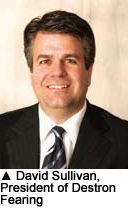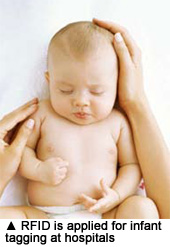RFID is poised for wider uptake, with limitless applications demanding more visibility. A&S looks at the market and applications for RFID, along with exciting opportunities ahead.
RFID is poised for wider uptake, with limitless applications demanding more visibility. a&s looks at the market and applications for RFID, along with exciting opportunities ahead.
Can't find that matching shirt in your closet? RFID could help you out soon.
Radio frequency tags have become smaller and cheaper, making item-level tagging a reality. By eliminating the need for line-of-sight solutions such as barcodes, RFID enable real-time contactless communication.
IDTechEx expected the RFID market to reach US$5.56 billion in 2009, up 5.9 percent from $5.25 billion in 2008, driven by large projects. "Looking at the range of applications, the biggest projects, which tend to be government-led and are usually profitable for suppliers involved, are unlikely to reverse," it said in a prepared statement. "For example, governments will not stop tagging passports or cattle to save money. Governments do not need a fast ROI. In industry, RFID is being applied where it can demonstrate a fairly rapid ROI."
RFID rollouts are strong for retail, particularly apparel and footwear. "Global sales of item-level RFID systems to apparel companies will essentially triple in size over the next five years, approaching $125 million by the end of 2014," said ABI Research in a prepared statement. It found retail apparel to be among the three "most promising" RFID hot spots, with asset management and active RFID projects to spur market growth by 12.7 percent per year until 2014.
 RFID's basic technology is unchanged, but what has changed is cost and availability. "An active tag has a battery, which can cost hundreds or dozens of dollars in some applications," said Scot Stelter, Director of Product Marketing, Impinj. "The far end of scale is passive RFID. A passive ID tag gets a signal from the reader and passively powered. That tag is really cheap. Because it's inexpensive, it can enable a huge array of applications that weren't feasible before."
RFID's basic technology is unchanged, but what has changed is cost and availability. "An active tag has a battery, which can cost hundreds or dozens of dollars in some applications," said Scot Stelter, Director of Product Marketing, Impinj. "The far end of scale is passive RFID. A passive ID tag gets a signal from the reader and passively powered. That tag is really cheap. Because it's inexpensive, it can enable a huge array of applications that weren't feasible before."
A smaller price tag means wider adoption for RFID, with passive tags making up the majority of volume. "Costs keep going down for readers and infrastructure, which enables people to use RFID more than in the past," Stelter said. "Gen 2 RFID is achieving higher levels of performance. For more applications to achieve ROI, they need to read 99 percent of the time to reach the critical threshold for the system to pay for itself."
More users are seeing the benefits of RFID. "We believe the trend is to extend the applications beyond pilot programs to full-scale applications," said Sri Hartati Kurniawan, CTO, RCG. "This is done after the companies realize the benefits RFID brings to their organizations."
There is a growing trend to secure RFID communication. "There's no security on traditional RFID," said Daniel Engels, CTO, Revere Security. "The ID is always sent in the clear, which creates major privacy issues. It enables tracking and tracing of individuals and can reveal information such as what items are being carried or what's being done with them."
 Revere Security offers an algorithm to encrypt RFID tags without impacting performance. "The tags will still be promiscuous; they will talk to any reader," Engels said. "But even if the tag talks to unauthorized readers, they just get a random ID. They can't trace you, crack you or violate your privacy."
Revere Security offers an algorithm to encrypt RFID tags without impacting performance. "The tags will still be promiscuous; they will talk to any reader," Engels said. "But even if the tag talks to unauthorized readers, they just get a random ID. They can't trace you, crack you or violate your privacy."
The Revere Security solution overcomes shortcomings in the data encryption standard (DES) and the more recent advanced encryption standard (AES). "AES is power hungry," Engels said. An RFID battery life study showed a tag with no security could last 10 years, while an AES tag would have 3.5 years of battery life. The Revere solution would last 9.2 years, with 256-bit encryption making it comparable in strength to AES.
The compact form factor suits RFID tags with limited memory. "It's a combination of fast, small and low-power," Engels said. "The ultimate goal of the Internet of things is that everything is tagged. It's not just throwing cryptography on top of a system, but into the system."
Applications
Access Control
RFID offers contactless advantages for hotels, as tags can be canceled if guests lose them and last longer than magstripes. "Onity's locking solution is engineered utilizing secure and reliable reader technology," said Leire Iriberri, Marketing for EMEA, Onity. The RFID door locks feature NXP Crypto-1 encoding and proprietary encryption of token data.
 The solution is compatible with legacy systems for added flexibility. "The modular design allows for a cost-effective upgrade path, making it easy and affordable to keep up with the latest security technology as it evolves," Iriberri said.
The solution is compatible with legacy systems for added flexibility. "The modular design allows for a cost-effective upgrade path, making it easy and affordable to keep up with the latest security technology as it evolves," Iriberri said.
Airports feature access control heavily, with RFID's read-write capabilities enabling up-to-date information. A CEM network access control solution was implemented at Heathrow Airport's Terminal Five. "More than 1,000 CEM card readers with advanced smart-card technology were installed throughout the terminal to secure access gates, air-bridges, check-in desks, and other protected access points," the company said in a prepared statement. About 235,000 smart cards were used to manage access.
Increased read ranges are suited for parking lots. "Passive tags can go up to a meter or a dozen meters now," Stelter said. "I can drive right up to the gate. It knows it's me and improves facility throughput."
Tracking
Longer read ranges for RFID tags can add location information for high-security applications. "Access control involves waving a little tag a centimeter away at a reader," Stelter said. "Models now have relatively free access and track your area, enabling forensic ability. If I'm in the secure area, the facility knows where I am."
The same positioning concept was deployed for an RCG patrol solution with portable readers. "The solution allows security personnel to patrol school premises carrying the device and performing verification checks at designated locations," Kurniawan said. Tags are installed at strategic locations throughout the school.
Health care relies on RFID to identify people and assets, which RCG deployed at the Sri Kota Hospital in Malaysia for infant tagging. "RFID readers were installed at various entrances and wards of the hospital, which detected tags passing through," Kurniawan said. "Should any patient or asset pass through the gateways without prior registration, the system would immediately trigger an alarm and show the current location at a centralized area."
 The hospital solution can also track students at day care centers or senior citizens in nursing homes, Kurniawan said.
The hospital solution can also track students at day care centers or senior citizens in nursing homes, Kurniawan said.
Additional tag storage can record medical files. "RFID is capable of massive storage of approximately 30,000 records," Kurniawan said. "Through RFID tags embedded on cards or wristbands, information including patient information, drug prescriptions, medical orders, patient history, reports and other medical administrative items can be stored on a single chip permanently."
Animal tagging can offer valuable insight. "Animal identification implants are used for companion pets, or identification of lost pets so they can be returned to their owners," said David Sullivan, President of Destron Fearing.
Cats and dogs use passive implanted tags, while tags for pigs, cows and sheep are attached externally with pierced studs. "For livestock, tags are used for food traceability and herd management," Sullivan said. "Both the visual and the RFID  ear tags provide identification functions, but the RFID one is able to collect and manage a great deal more data."
ear tags provide identification functions, but the RFID one is able to collect and manage a great deal more data."
An active Destron Fearing livestock tag has read-write capability and a read range of up to 100 feet. "The anti-collision software is highly advanced," Sullivan said. "The interrogator can read individual animals in a truckload of cattle passing by from considerable distance."
Asset Management
Beyond security, apparel tagging promises real-time business intelligence for retailers. "If all items are tagged with passive tags for 12 or 10 cents each, that reduces out of stocks," Stelter said. "The tag is removed at the point of sale, so there's no privacy issue. If all stores have that, they can inventory each store more efficiently."
An item-tagging application for American Apparel yielded 14 percent revenue growth, representing real ROI with RFID. "It's not just to cut cost," Stelter said.
While RFID cannot replace electronic article surveillance (EAS), it provides forensic shrink control. "If you use RFID to track apparel, from when it's off the pallet in the backroom or put it on the store floor, you know when it's sold," Stelter said. "You then have the ability to know when articles are missing."
This provides timely insight into shrinkage, as insiders account for the majority of losses. "If you know where a case of blouses were at a certain time, which then disappeared at a later time, you can narrow down when they went missing. You have some powerful evidence for the source of shrink," Stelter said.
In health care, stolen assets affect more than the bottom line. "The theft in hospitals is just unbelievable," Stelter said. "There are cases of patients walking out of hospitals with diagnostic equipment. They don't know what it is, but they know it's valuable."
RFID's ability to track objects has extended into banking, with stiff penalties for US banks that fail to protect consumer privacy. "If you're a large bank with data for millions of customers, you may need to retire a disk drive covered with confidential consumer information," Stelter said. "RFID enable systems to reliably track that disk drive until it's well and truly gone, and not available to the bad guys."
Outlook
The future looks rosy for RFID, with standardization enabling more communication. "The future is going toward integrating the different systems in one same wireless platform, and managing them all in real time," Iriberri said.
RFID will be integrated with sensors for more data. "At this time, we only have a temperature-sensing tag in beta sites," Sullivan said. "There has been talk of  glucosesensing tags for diabetes in pets, but that would require a great deal of time and money to develop and get through the Food and Drug Administration. Basically, if you can make a chip with a membrane that allows body fluids to pass through, you could test for all kinds of disease markers."
glucosesensing tags for diabetes in pets, but that would require a great deal of time and money to develop and get through the Food and Drug Administration. Basically, if you can make a chip with a membrane that allows body fluids to pass through, you could test for all kinds of disease markers."
Sensor integration will become more commonplace. "Imagine in the future, you buy a gallon of milk that has a passive tag with a freshness sensor," Stelter said. "You put it in a smart fridge and go on a four-day business trip. When you return, your refrigerator tells you the milk has gone bad. That technology is seen in the pharmaceutical industry right now."
Engels was part of the MIT Auto-ID Center, which developed the Electronic Product Code standard for tags. "If I'm in the bathroom and I'm out of shampoo, I can scan the shampoo's tag at the mirror and reorder shampoo," he said. "This was done at the Auto-ID Center a decade ago, which still seems futuristic but is absolutely becoming a reality for home health care."
Strengthening privacy on tags will be a key challenge to overcome, with credit card skimming posing real risk. "We've been able to skim cards from three meters away," Engels said. "The data on the credit card's HF tag — it's my credit card they're skimming— is insecure and is not encrypted at all. There is a severe lack of understanding, as people think the eavesdropping range is a couple inches, but can be increased to three meters if you violate the power limit."
RFID read speeds will get faster and more secure. "What's on the market today is not meeting security needs, particularly in UHF and active," Engels said. He cited a Brazilian traffic application deploying passive UHF tags for vehicle tagging and toll tagging. The user wanted security on the devices, while reading at three-to-five meters for vehicles going at 70 to 80 mph. However, when AES was added, the range dropped below three meters and the read speeds were degraded. A secure but fast encryption is "a growing concern and desire."
Medical RFID implants in humans can provide life-saving data, but have no privacy safeguards. "In health care and pharmaceutical especially, there are patient privacy issues for implanted medical devices," Engels said. "It comes down to battery life, primarily, which is significantly decreased when traditional security algorithms are added."
While malicious attacks can occur, some RFID applications are more concerned about identification. "Security isn't just about encrypting the information so eavesdroppers can't see it," Engels said. "In many applications, the entities are OK if eavesdroppers listen in, but they need authentication. If I can't authenticate the data came from Device One, I do not trust the data in that scenario. You do not want a pacemaker to get a command to change its rate from 60 beats per minute to 160, if the pacemaker does not know a valid command."
RFID has limitless potential, with added safeguards for privacy. It is no longer an exotic dream but an essential tool for the future.